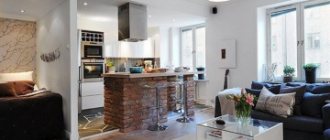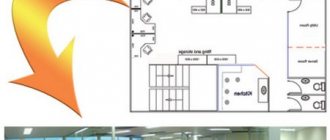There is a concept of living and total area of an apartment. They are not the same as each other, but are important in many cases. When selling, exchanging or otherwise alienating property, both indicators play an important role. Therefore, it is important to understand what is included in the living area of the apartment, and which rooms do not need to be taken into account.
What does "living space" mean?
When purchasing an apartment or making other real estate transactions, many questions arise. For example, about what the living space of an apartment means. The answer is simple - these are all premises that may be suitable directly for living. However, they cannot have any other purpose.
The term itself suggests its decoding, so dividing the apartment into places suitable and not suitable for permanent residence is not difficult. This indicator significantly affects the value of the property on the real estate market. The larger it is, the more expensive the entire object can be valued.
The cost also includes many other characteristics:
- convenience of location;
- floor;
- area, etc.
However, the area intended for permanent residence is the most important factor. The living area is not equal to the total, since it does not include some other types of premises that are available in the apartment, but are not suitable for their intended purpose.
The living area will always be less than the total.
Article 50. Requirements for residential premises
A comment :
1. According to the content of the commented article, criteria are established for residential premises that are provided to a person for residence. It must be well-equipped in relation to the conditions of a given locality and meet established sanitary and technical requirements.
Sanitary and technical requirements provide conditions under which a person can live without harm to her health. Landscaping is determined by the presence of communal amenities in the residential premises (water supply, sewerage, heating, gas supply, etc.).
Thus, a room may meet sanitary and technical requirements, but be disorderly, and vice versa. It should be taken into account that the level of improvement in different settlements and localities is different.
Therefore, the legislation connects the solution to the issue of the convenience of the provided residential premises with the specific conditions of the locality in which it was provided.
2. Residential premises provided to a citizen who is on the housing register do not necessarily have to be located in a new house. Vacant residential premises may also be provided if they meet the established requirements.
Providing citizens with residential premises that do not meet the established requirements is permitted only in cases of temporary improvement of housing conditions in the manner prescribed by the Apartment Registration Rules.
In particular, according to paragraph.
54 of the Rules, in some cases, at the request of citizens who are on the housing register (primarily those who have a priority for receiving residential premises), and citizens enjoying the right of priority receipt of residential premises in order to temporarily improve housing conditions, they may be provided with residential premises , which does not meet the requirements for livability, sanitary and technical requirements provided for, with the corresponding retention of the right to be registered and on the priority list or on the non-priority list.
3. According to Part 2 of Art. of the commented article, when providing residential premises, it is not allowed to occupy one room by persons of different sexes, over nine years of age, except for spouses. Apartment registration rules (clause
52) an additional ban has been established regarding the occupancy of one room by persons suffering from severe forms of certain chronic diseases, and therefore cannot live in the same room with members of their family.
It is also not allowed for an apartment built for one family to be occupied by two or more families or two or more single persons, except in cases provided for in Article 54 of the Housing Code of Ukraine.
The procedure for providing isolated living space that has been vacated in an apartment in which two or more tenants live (in a communal apartment), established in Art. 54 Residential Complex of the RSFSR.
It is general and applies to residential premises vacated in apartments built for one family.
If, according to this Procedure, an isolated residential premises, a vacated one (room, rooms) cannot be transferred to the tenant living in this apartment, it is provided to other persons. Thus, as an exception, another family or a single person may additionally move into an apartment built for one family.
Elderly persons, as well as corresponding categories of disabled and sick people, at their request, are provided with living quarters on the lower floors or in buildings with elevators.
The elderly referred to in the article include persons entitled to receive a pension on a general basis: men who have reached 60 years of age, women - 55 years of age.
The right of disabled people to receive living space on the ground floor or in a building equipped with an elevator is established by the medical advisory commission of the relevant medical institution.
On this information and legal website you can find everything you need to effectively implement your issue: comments on national laws, all major legislative acts, procedural documentation templates, a dictionary of legal terms, cases of court consideration and addresses of competent authorities and institutions Ukraine.
The national legal website of Law of Ukraine LLC provides an exceptional opportunity for you to get qualified legal advice - online legal advice from our professional lawyers. In general, if you are faced with a legal issue and you need professional legal assistance, fill out the question form. We will do everything to ensure that your rights and interests are reliably protected!
Housing law
The above characteristics were developed in the Decree of the Government of the Russian Federation of January 28, 2006 No. 47 “On approval of the Regulations on recognizing premises as residential premises, residential premises unsuitable for habitation and an apartment building as unsafe and subject to demolition or reconstruction” (as amended on 02.08. 2007 No. 494) (hereinafter referred to as the Regulations).
- load-bearing and enclosing structures of residential premises, including those that are part of the common property of the owners of premises in an apartment building, must be in working condition in which violations that arise during operation in terms of deformability (and in reinforced concrete structures - in terms of crack resistance) do not lead to disruption of the performance and load-bearing capacity of structures, the reliability of a residential building and ensure the safe stay of citizens and the safety of engineering equipment;
- the foundations and load-bearing structures of a residential building, as well as the foundations and load-bearing structures that are part of the common property of the owners of premises in an apartment building, must not have destruction or damage leading to their deformation or the formation of cracks, reducing their load-bearing capacity and impairing the operational properties of the structures or residential building as a whole;
- residential premises, as well as the common property of premises owners in an apartment building, must be arranged and equipped in such a way as to prevent the risk of injury to residents when moving in and around the residential premises;
- residential premises must be provided with engineering systems (electric lighting, drinking and hot water supply, drainage, heating and ventilation, and in gasified areas also gas supply);
- engineering systems (ventilation, heating, water supply, drainage, elevators, etc.), equipment and mechanisms located in residential premises, as well as those included in the common property of premises owners in an apartment building, must comply with sanitary and epidemiological safety requirements;
- external enclosing structures of residential premises, which are part of the common property of the owners of premises in an apartment building, must have thermal insulation that ensures in the cold season the relative humidity in the inter-apartment corridor and living rooms is no more than 60 percent, the temperature of heated premises is not less than +18 degrees Celsius, as well as insulation from the penetration of external cold air, vapor barrier from the diffusion of water vapor from the room, ensuring the absence of moisture condensation on the internal surfaces of non-transparent enclosing structures and preventing the accumulation of excess moisture in the structures of a residential building;
- residential premises, as well as premises that are part of the common property of premises owners in an apartment building, must be protected from the penetration of rain, melt and ground water and possible domestic water leaks from engineering systems using structural means and technical devices;
- access to residential premises located in an apartment building above the fifth floor, with the exception of the attic floor, must be via an elevator;
- and others.
The procedure for preparing documents to recognize the suitability of a house for habitation
First of all, you should register ownership of the property; this can be done by contacting the MFC. Without entering information about ownership into the unified register, it is impossible to carry out the procedure for recognizing a house as residential.
Read more: How to get diapers for a group 1 disabled person for free
The next document that needs to be completed is the BTI technical passport. This is a document that contains all the characteristics of the house (room plan, dimensions, design features). Based on the technical passport, examinations are carried out and the necessary conclusions are issued.
To obtain a technical passport, the owner needs to write an application to the BTI and pay a state fee. An on-site specialist will inspect the building, site and surrounding area and check documents.
Based on this survey, BTI will prepare a technical passport for the structure.
Information in the technical passport can serve as the basis for recognizing a garden house as residential if the relevant information is specified there.
These two documents are required both in case of legal proceedings and when applying to the regional executive authority.
Requirements for kindergartens
For kindergartens, a separate SanPiN 2.4.1.3049 13 is used.
This act establishes requirements for:
Source: https://KPPKDirection.ru/nezhilaya/tehnicheskie-normy-zhilogo-pomeshcheniya.html
What does this mean?
The question often arises about what constitutes living space in an apartment.
Living area is the total square footage of all rooms that are intended directly for living:
- bedrooms;
- living rooms;
- children's;
- guest, etc.
Common areas that are accessible to all residents of the apartment without exception are not included. These include a bathroom or toilet. Such premises are designed for specific narrow functions.
Is a kitchen a residential or non-residential space?
When determining living space, some types of premises are not included in the calculation:
- kitchen;
- corridor;
- bathroom, etc.
This is due to the fact that these particular premises do not have such a purpose as living. They refer to common areas for all persons living in the apartment. The kitchen is among those rooms that are included in the general square footage of the object, but are not intended for living.
Requirements for residential premises - State and law
Every person has the right to live in optimal living conditions. Therefore, certain requirements are imposed on any residential premises. To do this, numerous norms and rules of SanPiN are taken into account.
If they are violated, then this is the basis for registering citizens living in such conditions as those in need of housing. Therefore, the state should try in various ways to prevent the presence of such housing.
Requirements for residential premises include many aspects, which include:
- availability and condition of utilities;
- location of the residential property;
- features of the local area.
Where are the requirements stated?
When studying the condition of each room, the provisions of SanPiN 2.1.2.2645-10 are taken into account. These sanitary standards were adopted in 2010. This act is called “Requirements for living conditions in residential premises.” It is on them that a special interdepartmental commission is guided, determining the suitability of a particular premises for habitation.
The document lists the basic conditions, as well as requirements for the safety and comfort of living of citizens. The nuances of performing repair work or finishing the premises are given. SanPiN regulates numerous issues, which include:
- the conditions on the basis of which citizens are provided with living quarters after completion of construction work;
- standards observed by homeowners when operating premises, and they are developed during the design process of the building;
- requirements for the process of reconstruction of structures;
- rules and regulations observed even before the construction process;
- requirements that operating enterprises must meet.
SanPiN requirements apply not only to apartment buildings, but also to various hotels or hostels, as well as to residential buildings with a special purpose.
The procedure for recognizing premises as residential when a citizen applies to the MFC
The administration of a settlement or district, by order, creates an interdepartmental commission to conduct a comprehensive survey and establish the real condition of the premises. An employee of the district administration is appointed as the chairman of the commission.
The interdepartmental commission includes members of the following organizations:
- departments responsible for housing control;
- sanitary-epidemiological service;
- Ministry of Emergency Situations, which oversees fire safety of buildings;
- representatives of architectural supervision, urban planning, design experts and other representatives (if required by a specific case).
The interdepartmental commission determines the documents that the applicant must provide in order to recognize the property as suitable for habitation.
After the commission has carried out surveys and examinations, a conclusion is drawn up and signed by its participants on the compliance or non-compliance of the inspected real estate with the requirements of the Regulations on the recognition of premises as residential premises. If the commission does not recognize the premises as residential, the citizen must go to court.
What to do if the developer goes bankrupt?
There are often situations when citizens prefer to purchase real estate from a developer. In this case, they form a DDU with the construction company.
Based on this document, the developer must transfer the finished residential property to the buyers within a specific time frame. But sometimes a company declares itself bankrupt.
In this case, the house may already be completed, but the company does not have time to put it into operation.
Under such conditions, it is optimal for buyers to submit an application for a requirement to transfer the residential premises to the buyer. It is sent to the court, which is considering a specific bankruptcy case.
It creates a register of requirements for the transfer of residential premises. It is represented by a special list of requirements of all creditors. This document is studied by the court to determine what demands are being made by the plaintiffs.
They must be confirmed by official documents.
The register of requirements for residential premises includes the claims of all buyers of apartments under the DDU. Such a register was introduced on the basis of Federal Law No. 210.
Under such conditions, a specific bankruptcy procedure for a construction company is used, so not only the property is sold, but also finished objects are issued to buyers.
The requirement to transfer residential premises will be appropriate and legal if the developer completed the property before declaring bankruptcy.
What is required to be included in the registry?
Initially, the developer must declare bankruptcy. Next, the observation procedure begins, during which all creditors can present their claims. It is at this time that there is an opportunity to include requirements for the transfer of residential premises in the register. To do this, the shareholder must have documents submitted to the court:
- a correctly drawn up application for inclusion in the register of residential premises requirements;
- DDU drawn up with a bankrupt developer;
- document confirming payment for residential premises.
It is important not to miss the deadline set for filing an application, since from the moment of publication of information about the bankruptcy of the developer, the process can only be completed within two months. Documents are submitted to the arbitration court dealing with a specific bankruptcy case.
If there are grounds for inclusion in the register, then the shareholder is included among the creditors. By a court decision, the creditors' claims are satisfied, so the shareholder can receive a finished apartment, but at the same time it must meet numerous sanitary requirements.
Also, by court decision, the house can be completed if it has not yet been put into operation. Often it is sold to a new developer.
Source: https://uk-mishino.ru/nezhilaya-sobstvennost/trebovaniya-predyavlyaemye-k-zhilomu-pomeshcheniyu.html
How is the total area calculated?
The total living area includes:
- residential;
- non-residential
When using the term “total area” it is implied that absolutely the entire area of the object is taken into account. However, there are exceptions, since everything that is outside the apartment, but belongs to it, is not considered part of the total area.
To calculate the total area of the apartment, you need to add up the square footage of all individual sections:
- rooms directly suitable for living, including children's rooms, living rooms and others;
- kitchen;
- cabinets built into the wall, as well as niches;
- corridor, etc.
You need to be careful when buying real estate, since sellers often give exactly the general indicator of the property for living space.
What is included in the living area of the apartment? The concept of common and living space
The balcony is included in the area of the apartment. And the loggia too. Usually such space is also called useful. A variety of mezzanines are also included in the concept of usable area. In Russia this is exactly the interpretation used. But in other countries, usable area refers to only the usable premises in housing. What a mess!
Interesting read: Governor's support for young families in 2020 in St. Petersburg
What else is worth paying attention to? For example, what does the total area of the home include? This important indicator also plays a role for many. Using it, you can determine what space is allocated in general for your needs, and not just for living. This includes:
Does the balcony turn on or not?
According to current standards, a balcony or loggia is not included in either the residential or general square footage of the apartment. Balcony parameters must always be indicated separately during a sale or other transaction. It will not be possible to connect a balcony to a room in a legal way, since this is prohibited by Russian law.
Expert opinion
Irina Vasilyeva
Civil law expert
If the seller adds a loggia, terrace or balcony to the total or residential area of the quadrature, trying to increase the cost and total size of the object, he is doing it illegally.





